Differences in harvest time and flavor of spring tea, summer tea, autumn tea and winter tea in Darjeeling black tea
The change of seasons is perhaps one of the most beautiful phenomena in nature.
The seamless transition from summer to winter is spectacular, as is the quality brought by each season.
The blooming of flowers, the falling of leaves, the blowing of warm wind, the falling of snow, each season depicts a different picture for us, in one way, one way, arouses countless emotions.
The seasons designed by nature are unique and diverse. As a reflection, the season leads to unique characteristics from other things.
The best example I can think of is obviously tea. Whether it's grape sweetness, elegant taste, or floral scent, the time of harvest has a big impact on the nuances you enjoy in tea.
The harvest season is called flush in English. In India, especially Darjeeling Tea, there are five flowering seasons-three main harvest seasons and two intermediate seasons. Each season of tea is unique, full of personality, and different.

Spring tea
Also known as Spring flush, first flushes are so called because they mark the first harvest of the year. Leaves and buds are picked around March after the spring monsoon. Darjeeling spring tea is the treasure of every tea connoisseur because of its soft and delicate taste, rich aroma and light body. Darjeeling spring tea is usually used for export because it is very popular all over the world.
Mid-season tea
Tea picked after spring tea and before picking tea in summer. This happened at the end of April or early May.
Summer picked tea
Summer tea is harvested in June, also known as Xia Chong tea, because June is the midsummer season. The extraordinary musk tea is at the time of the red tide. This kind of tea usually has a mellow taste, a sweet aftertaste and a grape flavor. Summer-picked tea grown in Assam has brought a healthy competition with its rugged taste and rich taste.
Rainy season tea
As the name implies, the tide in the rainy season is the rain after picking tea in summer. At this time, the leaves are more mature and taste less delicious than in spring and summer. Monsoon herbal teas in Assam, Nirgiri and Darjeeling are produced by CTC and are used to mix teas such as masala chai.

Autumn tea
This brings the last harvest of the year, and the tea is picked around October. During the autumn tide, these teas are very delicate, although they are more full-bodied than spring and summer-picked teas. A cup of autumn tea has a spicy taste and a full taste.
Winter tea
Almost exclusively in the Nilgiri Mountains of southern India, the tea is harvested from December to January. In Nilgiri, winter and autumn tides are used alternately because there is no obvious autumn and winter in tropical South India. This is an undiscovered treasure, and the black tea picked from Nilgiri is rich in aroma and flavor.
Important Notice :
前街咖啡 FrontStreet Coffee has moved to new addredd:
FrontStreet Coffee Address: 315,Donghua East Road,GuangZhou
Tel:020 38364473
- Prev

Darjeeling black tea-typical flower and fruit fragrance Darjeeling spring tea tastes good? The difference between taste and summer tea
When I was drinking tea in the teahouse, I was tasting the whole universe, and the moment I raised the cup to my lips was eternity beyond time and space. When it comes to tea, do you think this is a bit of an exaggeration? Maybe. But then again, only tea can make people feel so deeply. This is the characteristic of this humble drink. It takes you into a world of contemplation. it
- Next

Which kind of tea tree tastes good?
In a scientific report, a straight-faced line says that there is a fairly standard timetable for innovation in Japanese tea production: once every 400 years. Tea cultivation is a conservative tradition, with many great names spanning centuries of tea planting culture, preserving topography, methods, skills and standards. What is clonal tea? Through clonal tea varieties, forward-looking science and embedded calendar
Related
- Beginners will see the "Coffee pull flower" guide!
- What is the difference between ice blog purified milk and ordinary milk coffee?
- Why is the Philippines the largest producer of crops in Liberia?
- For coffee extraction, should the fine powder be retained?
- How does extracted espresso fill pressed powder? How much strength does it take to press the powder?
- How to make jasmine cold extract coffee? Is the jasmine + latte good?
- Will this little toy really make the coffee taste better? How does Lily Drip affect coffee extraction?
- Will the action of slapping the filter cup also affect coffee extraction?
- What's the difference between powder-to-water ratio and powder-to-liquid ratio?
- What is the Ethiopian local species? What does it have to do with Heirloom native species?

